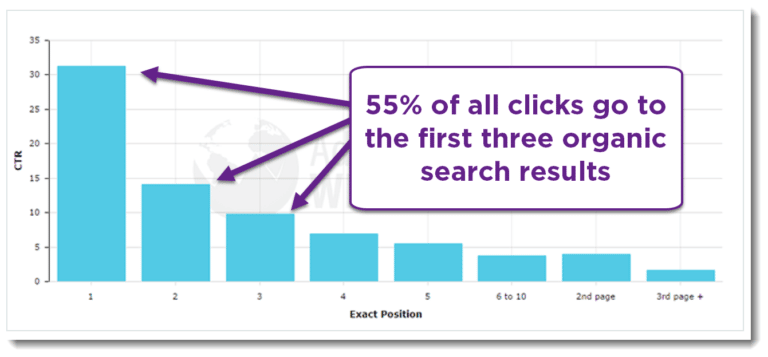SEO is extremely important. If you want to boost sales and get a leg up on the competition, you have to be on the first page of Google (or at least the first couple of pages). But to achieve that, you need to know exactly what could get you there—and that’s where the problems start for many.

Source: bluecorona.com
Google ranking is tricky, and is based on so many factors. In fact, in 2006, Google declared it was using over 200 factors to rank pages, which has been a controversial topic ever since.

Source: cloudfront.net
Does Google indeed use so many factors? Probably, yes. In fact, in 2010, Matt Cutts announced that each factor might have up to 50 variations, which makes the total number even more impressive. Do we know all the factors exactly? Unfortunately, no. Some of them are a definite truth; some are probable, and some are mere speculation and so on. Nevertheless, it’s important to know the basics of Google ranking to ensure your SEO strategy is as smart as it can be. So, let’s explore the first 50 of Google’s ranking factors.
DOMAIN FACTORS
1: DOMAIN AGE
It remains one of the factors that is named most often. However, this is not something you need to worry about much. As long as you’ve been around for a couple of months, you’ll show up in search results.
2: DOMAIN HISTORY
To Google, your domain acts like an ID. If it has a good history, Google knows it can be trusted. However, if it had several drops or was penalised for violating Google’s guidelines, it would be harder to make it visible again on organic search results. Therefore, always check the domain’s history to ensure it wasn’t owned by someone untrustworthy before.
3: DOMAIN REGISTRATION LENGTH
Though this one is controversial, Google could use domain data if they wanted to. Therefore, try to have at least a multi-year registration of your domain.
4: EXACT MATCH DOMAIN
Last year’s update shows that Google has reduced low-quality “exact match” domains in its search results.
5: KEYWORD IN SUBDOMAIN
Many SEO experts believe that having a keyword in your subdomain can boost rankings.
6: KEYWORD AS THE FIRST WORD IN DOMAIN
The same goes for this factor. It’s not obligatory, but using a keyword as the first word in your domain can boost rankings as well.
7: KEYWORD IN TOP-LEVEL DOMAIN
These days, it’s less significant than before. However, it could still make your website look more relevant.
8: PUBLIC VS PRIVATE WHOIS
This is also less relevant than before. However, mind that this could be perceived as you having something to hide, especially if you have a couple of websites with private WHOIS.
9: PENALISED WHOIS OWNER
If you are identified as a spammer, there’s a big chance that it will affect your other websites as well.
10: COUNTRY TLD EXTENSION
If you have a Country Code TLD, this could help your website rank better for a particular country. At the same time, it could also limit the site’s ability to rank globally.
PAGE-LEVEL FACTORS
11: IN-DEPTH TOPIC COVERAGE
This is a ranking factor that definitely matters. If you invest time and effort into the quality of your content, ensuring that it covers the topic in-depth, this will benefit your website.
12: PAGE LOADING SPEED VIA HTML
The Google webmaster team indicated that this factor does affect rankings. Search engine spiders use the page’s HTML code to estimate the speed of your website fairly accurately.
13: PAGE LOADING SPEED VIA CHROME
The same goes for Chrome data—Google may also use it to measure loading speed.
14: HISTORICAL PAGE UPDATES
The frequency of page updates might also play a role in Google rankings, helping your website look fresher and up-to-date.
15: KEYWORD IN TITLE TAG
Title tag remains an essential on-page SEO signal, though it might be less critical for rankings than before.
16: TITLE TAG STARTS WITH KEYWORD
Moz states that title tags starting with a keyword usually perform better than ones that have a keyword placed toward the end.

17: KEYWORD IN DESCRIPTION TAG
The meta description tag isn’t used as a direct ranking signal, but it can still impact click-through-rate—and that’s a key ranking factor.
18: KEYWORD IN H1 TAG
H1 tags are named “second title tags” for a reason. Google uses them as a secondary relevance signal.
19: KEYWORD DENSITY
It is less critical than before. However, if you use keywords wisely and place them strategically throughout the text, you might increase your chances of being ranked higher by Google. But be sure not to overdo it.
20: LSI KEYWORDS IN CONTENT
Latent semantic indexing (LSI) keywords help search engines better differentiate between words with more than one meaning. Their presence or absence could also act as a signal of a piece of content’s quality.
21: LSI KEYWORDS IN TITLE AND DESCRIPTION TAGS
They are also likely to act as a relevance signal.
22: KEYWORD PROMINENCE
Your goal isn’t to have all of the keywords within close proximity. However, it is definitely something you should consider.
23: KEYWORD IN H2, H3 TAGS
This might be a relevance signal as well; however, a weak one at best.
24: CONTENT LENGTH
It might seem as though readers appreciate shorter content over more in-depth pieces. However, longer content gains higher search ranks.
25: TABLE OF CONTENTS
If you include a linked table of contents, this could help Google understand the content on your page better.
26: DUPLICATE CONTENT
It is definitely bad for your site’s rankings.
27: CONTENT RECENCY
Google’s Freshness algorithm was launched in June 2010 and has affected the industry significantly. It’s always best to offer fresh, up-to-date content to rank higher on Google.
28: MAGNITUDE OF CONTENT UPDATES
All the edits and changes you make to your content could serve as a freshness factor as well.
29: SYNDICATED CONTENT
Though it’s possible to keep Google from penalising syndicated content, we still recommend avoiding it altogether. Syndicated content is terrible both for your rankings and for your audience.
30: HIDDEN CONTENT ON MOBILE
Though it’s okay to have, there’s a chance that it won’t get indexed or weighed as heavily as that which is fully visible.
31: VALUABLE SUPPLEMENTARY CONTENT
Things like currency converters, calculators, and so on aren’t merely useful: they could also enhance Google ranking.
32: CONTENT HIDDEN BEHIND TABS
Though this content might look impressive on a webpage, use it carefully as search crawlers might not index it.
33: OUTBOUND LINK QUALITY
Outbound links certainly matter for SEO. However, this only works when they are embedded in high-quality original content.

34: OUTBOUND LINK THEME
The content of the pages you link to can be used by Google as a relevance signal as well, so pay attention to it. You could either benefit from it, specifying what your page is about, or confuse Google even more; for example, writing about SEO but linking to food-related pages.
35: NUMBER OF OUTBOUND LINKS
Be careful with using too many dofollow links as this could actually hurt the rankings of the page.
36: NUMBER OF INTERNAL LINKS TO PAGE
The more often a page is linked to, the more important it seems to Google. Therefore, it’s crucial to not only include outbound links in your posts, but to do some internal cross-linking as well. This could increase the importance of specific pages throughout your domain in the eyes of Google. Furthermore, internal links influence customers to explore the various pages of your site.
37: QUALITY OF INTERNAL LINKS TO PAGE
Link to other content on your domain from your most authoritative pages. They impact the rankings much more than pages with a low PageRank or none at all.
38: BROKEN LINKS
Without a doubt, broken links are harmful for your rankings. They might tell Google that a website is either inactive or simply neglected. Therefore, try to find and fix them on time.
39: AFFILIATE LINKS
Generally, they won’t hurt your rankings, assuming you use them wisely. However, having too many of them could be bad for your website.
40: TF-IDF
TF-IDF is the product of two statistics, “term frequency” and “inverse document frequency”. It is used by search algorithms to better understand content that could be interpreted in various ways (“coke” could stand for Coca-Cola, cocaine, city in Texas and so on). This is actually quite an important SEO ranking factor. The more a specific word appears on a page, the more Google thinks the page is dedicated to that word.
41: USE OF AMP
Accelerated Mobile Pages is an open-source coding standard for publishers. As you probably know, different pages load at different speeds when you surf the web from your smartphone. AMP technology is used to optimise the mobile browsing experience, making it more or less the same for all mobile users. It isn’t a direct factor for ranking. However, it may be a requirement to rank in the mobile version of the Google News Carousel.
42: ENTITY MATCH
If a page’s content does match the “entity”—the topic a user is searching for—it might work as a ranking boost for that keyword.
43: GOOGLE HUMMINGBIRD
This algorithm is what helps Google understand the topic of a webpage better.
44: REL=CANONICAL
Remember that duplicate content part we were talking about? Well, this tag may prevent Google from penalising your website when you use duplicate content on it. However, it has to be used appropriately to achieve this result.
45: IMAGE OPTIMISATION
Image optimisation is centered around the quality and size of the images you use on your site. It’s always better when the size of the images is as small as possible while still maintaining superior visual quality. This affects performance directly, helping your website to load faster. Image optimisation could be neglected, but why do so when optimising your images could boost Google rankings?
46: GRAMMAR AND SPELLING
It is a controversial one; the latest news claims that grammar doesn’t impact SEO, though a couple of years ago, Matt Cutts stated the opposite. Generally speaking, proper grammar and spelling can contribute to rankings indirectly. If your content is well-written, the audience will spend more time reading it, which is a good thing.
47: MOBILE-FRIENDLY UPDATE
Mobilegeddon algorithm rewards pages that are optimised for mobile devices.
48: MOBILE USABILITY
Usability doesn’t merely make it easier for users to spend time on your webpage—it could improve your rankings as well.
49: MULTIMEDIA
Images, social media graphics, and other multimedia content could boost sales and improve your rankings at the same time.
50: READABILITY
There are many reasons why readability affects rankings. Therefore, consider investing time into making your texts easier to read. However, don’t overdo it. The complexity of the text should always depend on your audience. Making texts too simple could turn them away.
These are the first 50 Google ranking factors. Can you believe this is just the beginning? Stay with us to find out more about the factors that inevitably or possibly affect SEO.


